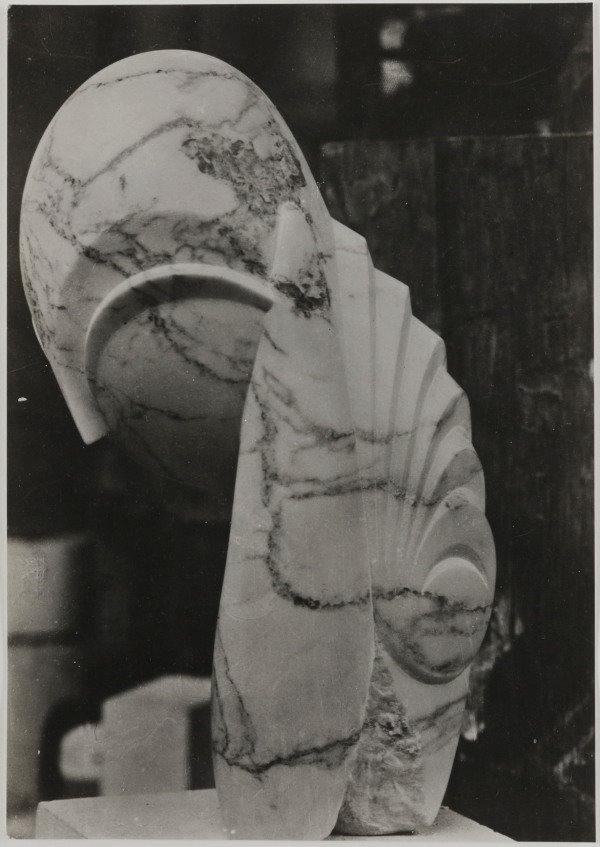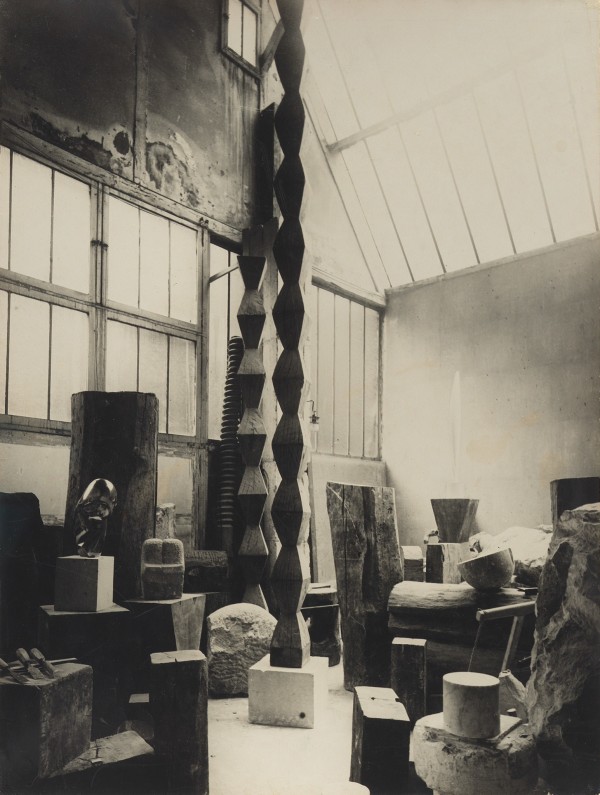Brancusi in New York 1913 – 2013
-
-
“[Brancusi] introduced three of the decisive inventions in sculpture of the twentieth century: environmental sculpture, minimalist sculpture, and serial sculpture.”
– Museum director and Brancusi expert, Pontus Hulten -
Paul Kasmin Gallery is pleased to present Brancusi in New York 1913 – 2013, an exhibition of works from the Brancusi Estate collection. The show celebrates Brancusi’s 100th anniversary in New York following his debut at the Armory Show in 1913, where the sculptor exhibited five works that directed modern sculpture on a radical new path.
The Gallery will present five masterpieces by Brancusi: Head, Mademoiselle Pogany II, The Newborn, Sleeping Muse II, and Fish. The works will be presented in a contemporary context at Paul Kasmin Gallery’s 515 West 27th Street location, from November 7, 2013 to January 24, 2014, as a testament to Brancusi's continued relevance in today’s art world. A fully illustrated catalogue, Brancusi in New York 1913 – 2013, published by Assouline, chronicles the sculptor’s success in New York City and his impact on its artistic milieu. The exhibition was produced in partnership with the Brancusi Estate and is curated by Jérôme Neutres, who is the catalogue’s author.
-
Together Head, Mademoiselle Pogany II, The Newborn, Sleeping Muse II, and Fish explore dominant themes in Brancusi’s oeuvre. Collectively and individually, they testify to his signature style admired by New Yorkers since 1913, and today they exemplify a sophisticated expression of perfected simplicity. With these sculptures, Brancusi shattered the paradigm of abstraction in sculpture and radicalized the idea of purity in form. Simply stated in the words of Jérôme Neutres, “Brancusi changed the way art was made.”
Head (circa 1920), made from polished bronze and measuring 7.5 by 9.5 by 11.75 inches in an edition of 5, illustrates how, in the words of Eugene Ionesco, “[Brancusi] had assimilated the entire history of sculpture, mastered it, gone beyond it, rejected it, come back to it, purified it, reinvented it. He had got it down to its essence.” With Head, Brancusi’s inquiry into the totemic nature of masks resulted in an interpretation that encapsulated his most complete geometric abstraction.
Mademoiselle Pogany II (1925), stands at 11.7 inches tall, in an edition of 8. The plaster model of the first version debuted at the Armory Show in 1913. The series of Mademoiselle Pogany was his most photographed work. Today this polished bronze version of Mademoiselle Pogany II still embodies the inexpressible nature of the feminine spirit.
Sleeping Muse II (1923), whose first version attracted the most attention in 1913, resulted in his first requests from collectors for bronze editions. It features also an abstracted face of a woman, like Mademoiselle Pogany II’s serpentine figure beckons the viewer with her subdued look. Sleeping Muse II transforms the viewer into a voyeur watching over the sleeping woman with delicate suggestions of a nose, large oval-shaped closed eyes, and a half-open mouth.
“We do not see real life except by its reflection,” wrote Brancusi in 1919, and with The Newborn (1920) Brancusi created his most radically abstract sculpture representing not only the act of birth but also the newborn baby. Previously Brancusi named it Beginning of the World, referencing the violence with which human life begins. But Brancusi tempers this association with the smooth lines of the sculpture, bringing serenity into the subject matter.
With Fish (1926), the artist advances his study of sculpture into a moving artwork. Fish, a polished bronze sculpture measuring 5.3 x 16.5 x 1.2 inches in an edition of 8, rotates on its disc allowing the sculpture to mimic the movement and spirit of its subject. Fish was born out of Brancusi’s goal to capture a creature’s movement, one he worked obsessively towards.
“Without the Americans, I would not have been able to produce all this or even to have existed," said Constantin Brancusi to the New York Times in 1955 when the Solomon R. Guggenheim Museum celebrated his work with the first museum retrospective of his work. Brancusi’s second Guggenheim retrospective occurred in 1969, and was held in the museum’s Frank Lloyd Wright rotunda. MoMA included works by Brancusi in more than ten group exhibitions between 1934 and his death in 1957. It took until 1967 for a French museum to have a show dedicated to his work (Tribute to Brancusi, at the Musee National d’Art Moderne in Paris) and until 1995 for the first full-scale exhibition in his adopted country at the Pompidou Center.
The exhibition design by studioMDA’s founder Markus Dochantschi plays with scale and perception, inviting the viewer to experience the non-linear geometry of the sculptures within the linear pattern of the exhibition layout, which Dochantschi modeled after the Manhattan grid. Brancusi viewed architecture as “inhabited sculpture” and saw echoes of his work in the New York skyline. In this exhibition, his bronze sculptures are placed on solid limestone pedestals, merging Brancusi’s fluid and seamless forms with supports that reflect the regimented layout of New York.
BRANCUSI IN NEW YORK 1913 – 2013 – ASSOULINE
Brancusi New York 1913 - 2013 by Jérôme Neutres "Manhattan is my large-scale studio. ...How is it similar to my studio? Because nothing is static. Nothing is fixed. All these buildings, all these forms, are interchangeable and can move as experience evolves and changes." --Constantin Brancusi
The pure, abstract sculptures made by Constantin Brancusi have had a large and enthusiastic audience in New York ever since they were first shown on American soil at the 1913 Armory Show. The numerous American collectors, muses, friends, and exhibitions that enabled his success had a profound influence on the eccentric Romanian artist who lived in Paris. And the feeling was definitely reciprocated. From the trial concerning his Bird in Space—which helped define modern art—to his first museum retrospective, and his dream of a skyscraper sculpture, New York was the place where Brancusi’s career unfolded. Over the last one hundred years his effect on the city’s art scene has never waned. Through stunning archival images and text by Brancusi authority Jérôme Neutres, Brancusi New York tells the story of the mutually beneficial relationship between the sculptor and the Big Apple. The book also features gorgeous new photographs of the five bronze sculptures on display at the Paul Kasmin Gallery in New York for the exhibition Brancusi in New York: 1913–2013.
Jérôme Neutres has been the special advisor to the president of the Réunion des Musées Nationaux–Grand Palais since 2010, and he is a board member of the Guimet Museum, both in Paris. He holds a PhD in philosophy and literature and is the author of many essays and books on literature and the arts. Formerly he was the cultural attaché of the French Embassy in the United States, based in New York. He has curated numerous modern and contemporary art exhibitions, including: Jean-Michel Basquiat, French Collections at the French Embassy in New York (2007); Helmut Newton at the Grand Palais (2012); Du côté de chez Jacques-Émile Blanche at the Fondation Pierre Bergé–Yves Saint Laurent (2012); and two upcoming shows, Bill Viola and Robert Mapplethorpe at the Grand Palais (2014).
For more information please contact info@kasmingallery.com
For press inquiries, please contact press@kasmingallery.com -
-
Brancusi in New York 1913 - 2013 on Charlie Rose
-
Works




![Constantin Brancusi, Le Nouveau-Né [II] et Tête d’enfant endormi (Newborn [II] and Head of a Sleeping Child), ca. 1923 (printed 1930s)](https://artlogic-res.cloudinary.com/w_600,c_limit,f_auto,fl_lossy/artlogicstorage/pkg/images/view/a09c1f3f4a6137a962e77e87115bd561j/kasmingallery-constantin-brancusi-le-nouveau-n-ii-et-t-te-d-enfant-endormi-newborn-ii-and-head-of-a-sleeping-child-ca.-1923-printed-1930s.jpg)








